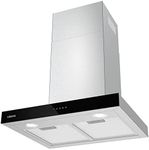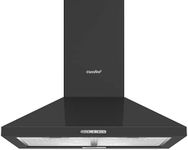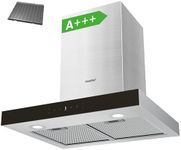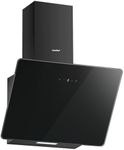Buying Guide for the Best Extractor Fan For Kitchen
Choosing the right extractor fan for your kitchen is essential for maintaining good air quality and removing unwanted odors, smoke, and grease. The right extractor fan can make your cooking experience more pleasant and keep your kitchen cleaner. Here are some key specifications to consider when selecting an extractor fan for your kitchen.Airflow CapacityAirflow capacity, measured in cubic meters per hour (m³/h) or cubic feet per minute (CFM), indicates how much air the fan can move. This is important because it determines how effectively the fan can remove smoke, steam, and odors from your kitchen. For small kitchens, a lower airflow capacity (around 200-300 m³/h) may be sufficient, while larger kitchens or those with heavy cooking needs may require a higher capacity (400 m³/h or more). Consider the size of your kitchen and your cooking habits to choose the right airflow capacity.
Noise LevelNoise level, measured in decibels (dB), indicates how loud the fan will be when in operation. This is important because a noisy fan can be disruptive and unpleasant, especially in open-plan living spaces. Noise levels typically range from 40 dB (quiet) to 70 dB (loud). If you prefer a quieter kitchen environment, look for fans with lower noise levels. Consider how sensitive you are to noise and whether the kitchen is close to living or sleeping areas.
Extraction TypeExtractor fans can be ducted or recirculating. Ducted fans vent air outside, which is more effective at removing moisture and odors but requires an external vent. Recirculating fans filter and recirculate the air back into the kitchen, which is easier to install but less effective at removing moisture. Choose a ducted fan if you can install external venting and want maximum effectiveness. Opt for a recirculating fan if installation constraints prevent external venting.
Filter TypeExtractor fans use filters to trap grease and odors. Common filter types include metal grease filters, which are washable and durable, and charcoal filters, which need regular replacement. Metal filters are ideal for heavy cooking as they are easy to clean and maintain. Charcoal filters are better for light cooking and when using a recirculating fan. Consider your cooking frequency and maintenance preferences when choosing the filter type.
Fan Speed SettingsFan speed settings allow you to adjust the extraction power based on your cooking needs. This is important for flexibility, as different cooking activities produce varying amounts of smoke and odors. Fans typically offer 2 to 4 speed settings. More speed settings provide greater control, allowing you to use lower speeds for simmering and higher speeds for frying. Consider your cooking habits and the need for adjustable extraction power.
Size and DesignThe size and design of the extractor fan should match your kitchen layout and aesthetic. This is important for both functionality and visual appeal. Fans come in various sizes to fit different hob widths, typically ranging from 60 cm to 90 cm. Choose a fan that is at least as wide as your hob for effective extraction. Additionally, consider the design and finish to ensure it complements your kitchen decor. Think about the space available and the overall look you want to achieve.














